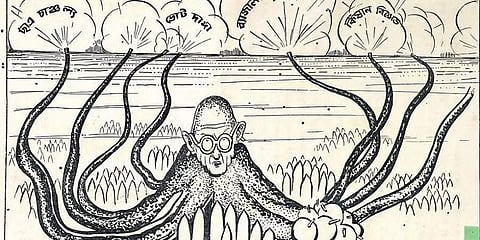
- LIFESTYLE
- FASHION
- FOOD
- ENTERTAINMENT
- EVENTS
- CULTURE
- VIDEOS
- WEB STORIES
- GALLERIES
- GADGETS
- CAR & BIKE
- SOCIETY
- TRAVEL
- NORTH EAST
- INDULGE CONNECT

Gandhiji is an octopus, a coy bride and Frankenstein. Netaji is in various garbs—Macbeth, Hamlet and a nurse. Sardar Patel is a school teacher pulling an offending Netaji by his ear. Jinnah, Gandhi and Netaji ride a giraffe to reach the moon to placate a bawling India.
This is the satirical tone of around 150 cartoons displayed in an exhibition, titled Political Cartoons from Bengal 1950-70, last month at the India International Centre in Delhi. The man behind the display of digital prints, published in journals, magazines and newspapers in pre- and post-Partition Bengal, is curator, collector and researcher Samit Das.
On the 75th anniversary of Indian Independence, these personalities have risen from the dead to haunt present-day politics as “fascism, Indo-China-Pakistan border issues, casteism, not to speak of communalism, are still alive”, says the 52-year-old. For those who missed the exhibition, the Kala Bhavana-trained artist will soon come out with a book and an online flipbook on the political cartoons.
On display at the show were the works of cartoonists and illustrators Saila Narayan Chakraborty, Debiprasad Roy Choudhury, Kutty, Chandi Lahiri, Rebati Bushan, Amal Chakraborty, among others. “I discovered something else while going through my collection. Well-known Bengali artists and illustrators of those days such as Saila, Binoy Krishna Basu and sculptor Debi Prosad Roychowdhury (a wry comment on the arty crowd) all used to contribute cartoons. They had a strong political voice,” says the curator.
Besides the famous caricatures of Gaganendranath Tagore, which did not spare his uncle Rabindranath, the cartoons also featured personalities such as Nehru, Jinnah, Patel, Shyama Prasad Mookerjee, and Cyril Radcliffe, the man who partitioned the Indian subcontinent.
Delhi-based Das is an avid collector of books on art writing, art reproduction and publications and journals like Prabasi, Bangashri, Taruner Swapna and Masik Basumati that appeared from 1930 to the early 1970s. “In the 1970s and 80s, the weekly Desh published from Kolkata ran a column titled Sunandar Journal, which was often penned by litterateur Sunil Gangopadhyay. It carried cartoons. The books in my collection reflected the zeitgeist, the controversies, political tussles and strife between the Centre and the state governments, and the rise of Communism in the 1970s.
While going through these papers, I came upon many illustrations and cartoons, some of which I had displayed,” says Das, who has also curated several exhibitions in the past, including Architecture of Santiniketan: Tagore’s Concept of Space in 2017.
Hand-drawn cartoons are rare these days, says Das. “They have been replaced by memes generated by mobile apps, software and artificial intelligence-based programmes. Once an indispensable part of dailies, cartoons have practically disappeared,” he bemoans. Hopefully, the volume he plans to bring out this year will restore the glory of this witty, yet profound art form.